Assessment of Salicylic Acid in Castor Oil Content Increase in Emissions of Its Biodiesel Blends
Abstract
:1. Introduction
2. Materials and Methods
2.1. Experimental Conditions
2.2. Plant Materials
2.3. Elicitation Process and Harvest
2.4. Plant Measurements
2.5. Soxhlet Extraction
Oil Extraction and Purification for Biodiesel Preparation
2.6. Oil Characterization
2.7. Biodiesel Production
2.8. Emission Tests
2.9. Ricinus communis Biodiesel Physicochemical Properties
2.10. Statistical Analysis for Oil Content and Emissions
3. Results and Discussion
3.1. Plant Morphology Measurement and Seed Weight
3.2. Oil Content and Characterization of Ricinus communis Seeds
3.3. Emission Tests
3.4. Biodiesel of Ricinus communis Elicitated by Salicilyc Acid Effect on Emissions
3.5. Physicochemical Properties of Ricinus communis Biodiesel
4. Conclusions
Author Contributions
Funding
Institutional Review Board Statement
Data Availability Statement
Acknowledgments
Conflicts of Interest
References
- Mondal, B.; Das, S.K. Comparative evaluation of mahua (Bassia latifolia) oil cake and castor bean (Ricinus communis) seed as fish toxicants for tilapia (Oreochromis mossambicus) and panchax (Aplocheilus panchax) with residual toxicity assessment on Labeo bata. Aquac. Res. 2019, 50, 2341–2349. [Google Scholar] [CrossRef]
- Singh, P.K.; Gautam, S. Role of salicylic acid on physiological and biochemical mechanism of salinity stress tolerance in plants. Acta Physiol. Plant. 2013, 35, 2345–2353. [Google Scholar] [CrossRef]
- Nekhavhambe, E.; Mukaya, H.E.; Nkazi, D.B. Development of castor oil–based polymers: A review. J. Adv. Manuf. Process. 2019, 1, e10030. [Google Scholar] [CrossRef]
- Baskar, G.; Aberna Ebenezer Selvakumari, I.; Aiswarya, R. Biodiesel production from castor oil using heterogeneous Ni doped ZnO nanocatalyst. Bioresour. Technol. 2018, 250, 793–798. [Google Scholar] [CrossRef]
- Chen, G.Q.; Johnson, K.; Morales, E.; Ibáñez, A.M.; Lin, J.-T. A high-Oil castor cultivar developed through recurrent selection. Ind. Crop. Prod. 2018, 111, 8–10. [Google Scholar] [CrossRef] [Green Version]
- Canoira, L.; Galeán, J.G.; Alcántara, R.; Lapuerta, M.; García-Contreras, R. Fatty acid methyl esters (FAMEs) from castor oil: Production process assessment and synergistic effects in its properties. Renew. Energy 2010, 35, 208–217. [Google Scholar] [CrossRef]
- Conceição, M.M.; Candeia, R.A.; Silva, F.C.; Bezerra, A.F.; Fernandes, V.J.; Souza, A.G. Thermoanalytical characterization of castor oil biodiesel. Renew. Sustain. Energy Rev. 2007, 11, 964–975. [Google Scholar] [CrossRef]
- Maleki, E.; Aroua, M.K.; Sulaiman, N.M.N. Castor oil—A more suitable feedstock for enzymatic production of methyl esters. Fuel Process. Technol. 2013, 112, 129–132. [Google Scholar] [CrossRef]
- Mukesh, D.; Iyer, R.S.; Wagh, J.S.; Mokashi, A.A.; Banerji, A.A.; Newadkar, R.V.; Bevinakatti, H.S. Lipase catalysed transesterification of castor oil. Biotechnol. Lett. 1993, 15, 251–256. [Google Scholar] [CrossRef]
- Panwar, N.; Shrirame, H.Y.; Rathore, N.; Jindal, S.; Kurchania, A. Performance evaluation of a diesel engine fueled with methyl ester of castor seed oil. Appl. Therm. Eng. 2010, 30, 245–249. [Google Scholar] [CrossRef]
- Dimian, A.C.; Iancu, P.; Plesu, V.; Bonet-Ruiz, A.-E.; Bonet-Ruiz, J. Castor oil biorefinery: Conceptual process design, simulation and economic analysis. Chem. Eng. Res. Des. 2019, 141, 198–219. [Google Scholar] [CrossRef]
- Leal, J.F.V.; Rios, I.H.; Méndez-Gallegos, S.D.J.; Ventura-Ramos, E.J.; Cuellar-Núñez, M.L.; Mosquera-Artamonov, J.D. Relación entre la composición química de la semilla y la calidad de aceite de doce accesiones de Ricinus communis L. Rev. Mex. De Cienc. Agrícolas 2017, 8, 1343–1356. [Google Scholar] [CrossRef] [Green Version]
- Luciano, A.-J.; Irineo, T.-P.; Virginia, O.-V.R.; Feregrino-Perez, A.A.; Hernandez, A.C.; Gerardo, G.-G.R. Integrating Plant Nutrients and Elicitors for Production of Secondary Metabolites, Sustainable Crop Production and Human Health: A Review. Int. J. Agric. Biol. 2017, 19, 391–402. [Google Scholar] [CrossRef]
- Iriti, M.; Varoni, E.M. Chitosan-induced antiviral activity and innate immunity in plants. Environ. Sci. Pollut. Res. 2015, 22, 2935–2944. [Google Scholar] [CrossRef]
- Garcia-Mier, L.; Jimenez-Garcia, S.N.; Guevara-González, R.G.; Feregrino-Perez, A.A.; Contreras-Medina, L.M.; Torres-Pacheco, I. Elicitor Mixtures Significantly Increase Bioactive Compounds, Antioxidant Activity, and Quality Parameters in Sweet Bell Pepper. J. Chem. 2015, 2015, 269296. [Google Scholar] [CrossRef] [Green Version]
- Jimenez-Garcia, S.N.; Vazquez-Cruz, M.A.; Guevara-González, R.G.; Torres-Pacheco, I.; Cruz-Hernandez, A.; Feregrino-Perez, A.A. Current Approaches for Enhanced Expression of Secondary Metabolites as Bioactive Compounds in Plants for Agronomic and Human Health Purposes. Pol. J. Food Nutr. Sci. 2013, 63, 67–78. [Google Scholar] [CrossRef] [Green Version]
- Sharma, A.; Sidhu, G.P.S.; Araniti, F.; Bali, A.S.; Shahzad, B.; Tripathi, D.K.; Brestic, M.; Skalicky, M.; Landi, M. The Role of Salicylic Acid in Plants Exposed to Heavy Metals. Molecules 2020, 25, 540. [Google Scholar] [CrossRef] [Green Version]
- Tiwari, P.; Indoliya, Y.; Chauhan, A.S.; Singh, P.; Singh, P.K.; Singh, P.C.; Srivastava, S.; Pande, V.; Chakrabarty, D. Auxin-salicylic acid cross-talk ameliorates OsMYB–R1 mediated defense towards heavy metal, drought and fungal stress. J. Hazard. Mater. 2020, 399, 122811. [Google Scholar] [CrossRef]
- Mahalakshmi, R.; Eganathan, P.; Parida, A.; Parida, A. Salicylic acid elicitation on production of secondary metabolite by cell cultures of Jatropha Curcas L. Int. J. Pharm. Pharm. Sci. 2013, 5, 655–659. [Google Scholar]
- Zavala-Gómez, C.E.; Rodríguez-Deleón, E.; Bah, M.M.; Feregrino-Pérez, A.A.; Campos-Guillén, J.; Amaro-Reyes, A.; Rodríguez-Morales, J.A.; García-Trejo, J.F.; Flores-Macias, A.; Figueroa-Brito, R.; et al. Effect of Salicylic Acid in the Yield of Ricinine in Ricinus communis under Greenhouse Condition. Plants 2021, 10, 1902. [Google Scholar] [CrossRef]
- Gorni, P.H.; Pacheco, A.C. Growth promotion and elicitor activity of salicylic acid in Achillea millefolium L. Afr. J. Biotechnol. 2016, 15, 657–665. [Google Scholar] [CrossRef]
- Estaji, A.; Niknam, F. Foliar salicylic acid spraying effect’ on growth, seed oil content, and physiology of drought-stressed Silybum marianum L. plant. Agric. Water Manag. 2020, 234, 106116. [Google Scholar] [CrossRef]
- Momeni, M.; Pirbalouti, A.G.; Mousavi, A.; Badi, H.N. Effect of Foliar Applications of Salicylic Acid and Chitosan on the Essential Oil of Thymbra spicata L. under Different Soil Moisture Conditions. J. Essent. Oil Bear. Plants 2020, 23, 1142–1153. [Google Scholar] [CrossRef]
- Arunkumar, M.; Kannan, M.; Murali, G. Experimental studies on engine performance and emission characteristics using castor biodiesel as fuel in CI engine. Renew. Energy 2019, 131, 737–744. [Google Scholar] [CrossRef]
- Salvador, M.H.; Guadalupe, C.H.M.; Miguel, H.M.; Tomás, M.C. Guanajuatoil Variedad de Higuerilla Para la Extracción de Aceite Industrial Para Guanajuato. Guanajuato México, August 2018. Available online: https://es.scribd.com/document/447504555/4774-Produccion-de-semilla-de-higuerilla-Ricinus-communis-L-en-Guanajuato (accessed on 24 August 2022).
- Akbari, G.A.; Heshmati, S.; Soltani, E.; Dehaghi, M.A. Influence of Seed Priming on Seed Yield, Oil Content and Fatty Acid Composition of Safflower (Carthamus tinctorius L.) Grown Under Water Deficit. Int. J. Plant Prod. 2019, 14, 245–258. [Google Scholar] [CrossRef]
- Shaki, F.; Maboud, H.E.; Niknam, V. Effects of salicylic acid on hormonal cross talk, fatty acids profile, and ions homeostasis from salt-stressed safflower. J. Plant Interact. 2019, 14, 340–346. [Google Scholar] [CrossRef] [Green Version]
- Zhou, L.; Yan, T.; Chen, X.; Li, Z.; Wu, D.; Hua, S.; Jiang, L. Effect of high night temperature on storage lipids and transcriptome changes in developing seeds of oilseed rape. J. Exp. Bot. 2018, 69, 1721–1733. [Google Scholar] [CrossRef] [Green Version]
- El-Shraiy, M.; Hegazi, A.M. Effect of acetylsalicylic acid, indole-3- bytric acid and gibberellic acid on plant growth and yield of pea (Pisum sativum L.). Aust. J. Basic Appl. Sci. 2009, 3, 3514–3523. [Google Scholar]
- Amin, A.; Rashad, E.M.; El-Abagy, H.M. Physiological Effect of Indole-3-Butyric Acid and Salicylic Acid on Growth, Yield and Chemical Constituents of Onion Plants. J. Appl. Sci. Res. 2007, 3, 1554–1563. [Google Scholar]
- Karlidag, H.; Yildirim, E.; Turan, M. Salicylic acid ameliorates the adverse effect of salt stress on strawberry. Sci. Agric. 2009, 66, 180–187. [Google Scholar] [CrossRef]
- Aghaeifard, F.; Babalar, M.; Fallahi, E.; Ahmadi, A. Influence of humic acid and salicylic acid on yield, fruit quality, and leaf mineral elements of strawberry (Fragaria × Ananassa duch.) cv. Camarosa. J. Plant Nutr. 2016, 39, 1821–1829. [Google Scholar] [CrossRef]
- Ghilavizadeh, A.; Masouleh, E.H.; Zakerin, H.R.; Valadabadi, S.A.R.; Sayfzadeh, S.; Yousefi, M. Influence of Salicylic Acid on Growth, Yield and Macro-elements Absorption of Fennel (Foeniculum vulgare Mill.) under Water Stress. J. Med. Plants By-Prod. 2019, 8, 67–75. [Google Scholar] [CrossRef]
- Simaei, M.; Khavari-Nejad, R.A.; Bernard, F. Exogenous Application of Salicylic Acid and Nitric Oxide on the Ionic Contents and Enzymatic Activities in NaCl-Stressed Soybean Plants. Am. J. Plant Sci. 2012, 03, 1495–1503. [Google Scholar] [CrossRef]
- Miura, K.; Tada, Y. Regulation of water, salinity, and cold stress responses by salicylic acid. Front. Plant Sci. 2014, 5, 4. [Google Scholar] [CrossRef] [Green Version]
- Hara, M.; Furukawa, J.; Sato, A.; Mizoguchi, T.; Miura, K. Abiotic Stress and Role of Salicylic Acid in Plants. In Abiotic Stress Responses in Plants; Springer: Berlin/Heidelberg, Germany, 2012; pp. 235–251. [Google Scholar] [CrossRef]
- Golkar, P.; Taghizadeh, M.; Yousefian, Z. The effects of chitosan and salicylic acid on elicitation of secondary metabolites and antioxidant activity of safflower under in vitro salinity stress. Plant Cell Tissue Organ Cult. 2019, 137, 575–585. [Google Scholar] [CrossRef]
- Khodary, S.E.A. Effect of Salicylic Acid on the Growth, Photosynthesis and Carbohydrate Metabolism in Salt Stressed Maize Plants. Int. J. Agric. Biol. 2004, 6, 5–8. [Google Scholar]
- Raskin, I.; Ehmann, A.; Melander, W.R.; Meeuse, B.J.D. Salicylic Acid: A Natural Inducer of Heat Production in Arum Lilies. Science 1987, 237, 1601–1602. [Google Scholar] [CrossRef]
- Geethanjali, G.; Padmaja, K.V.; Prasad, R.B.N. Synthesis, Characterization, and Evaluation of Castor Oil-Based Acylated Derivatives as Potential Lubricant Base Stocks. Ind. Eng. Chem. Res. 2016, 55, 9109–9117. [Google Scholar] [CrossRef]
- Román-Figueroa, C.; Cea, M.; Paneque, M.; González, M.E. Oil Content and Fatty Acid Composition in Castor Bean Naturalized Accessions under Mediterranean Conditions in Chile. Agronomy 2020, 10, 1145. [Google Scholar] [CrossRef]
- Huang, F.; Bao, C.; Peng, M.; Zhu, G.; He, Z.; Chen, X.; Luo, R.; Zhao, Y. Chromatographic analysis of fatty acid composition in differently sized seeds of castor accessions. Biotechnol. Biotechnol. Equip. 2015, 29, 892–900. [Google Scholar] [CrossRef] [Green Version]
- Jachmanian, I.; Villamil, J.; Villamil, J.J. El Cultivo De Tártago (Ricinus communis L.) En El Uruguay: Información Preliminar,” Uruguay. 2009. Available online: http://www.inia.org.uy (accessed on 24 August 2022).
- Rivera-Brenes, P.A.; Hernández-López, J. Evaluación del rendimiento y calidad del aceite de siete variedades de Ricinus communis. Agron. Mesoam. 2015, 27, 183–190. [Google Scholar] [CrossRef] [Green Version]
- Özcanli, M.; Serin, H.; Saribiyik, O.Y.; Aydin, K.; Serin, S. Performance and Emission Studies of Castor Bean (Ricinus communis) Oil Biodiesel and Its Blends with Diesel Fuel. Energy Sources Part A Recover. Util. Environ. Eff. 2012, 34, 1808–1814. [Google Scholar] [CrossRef]
- Azad, K.; Rasul, M. Performance and combustion analysis of diesel engine fueled with grape seed and waste cooking biodiesel. Energy Procedia 2019, 160, 340–347. [Google Scholar] [CrossRef]
- Bueno, A.V.; Pereira, M.P.B.; Pontes, J.V.D.O.; de Luna, F.M.T.; Cavalcante, C.L. Performance and emissions characteristics of castor oil biodiesel fuel blends. Appl. Therm. Eng. 2017, 125, 559–566. [Google Scholar] [CrossRef]
- Arunkumar, M.; Mohanavel, V.; Afzal, A.; Sathish, T.; Ravichandran, M.; Khan, S.; Abdullah, N.; Bin Azami, M.; Asif, M. A Study on Performance and Emission Characteristics of Diesel Engine Using Ricinus communis (Castor Oil) Ethyl Esters. Energies 2021, 14, 4320. [Google Scholar] [CrossRef]
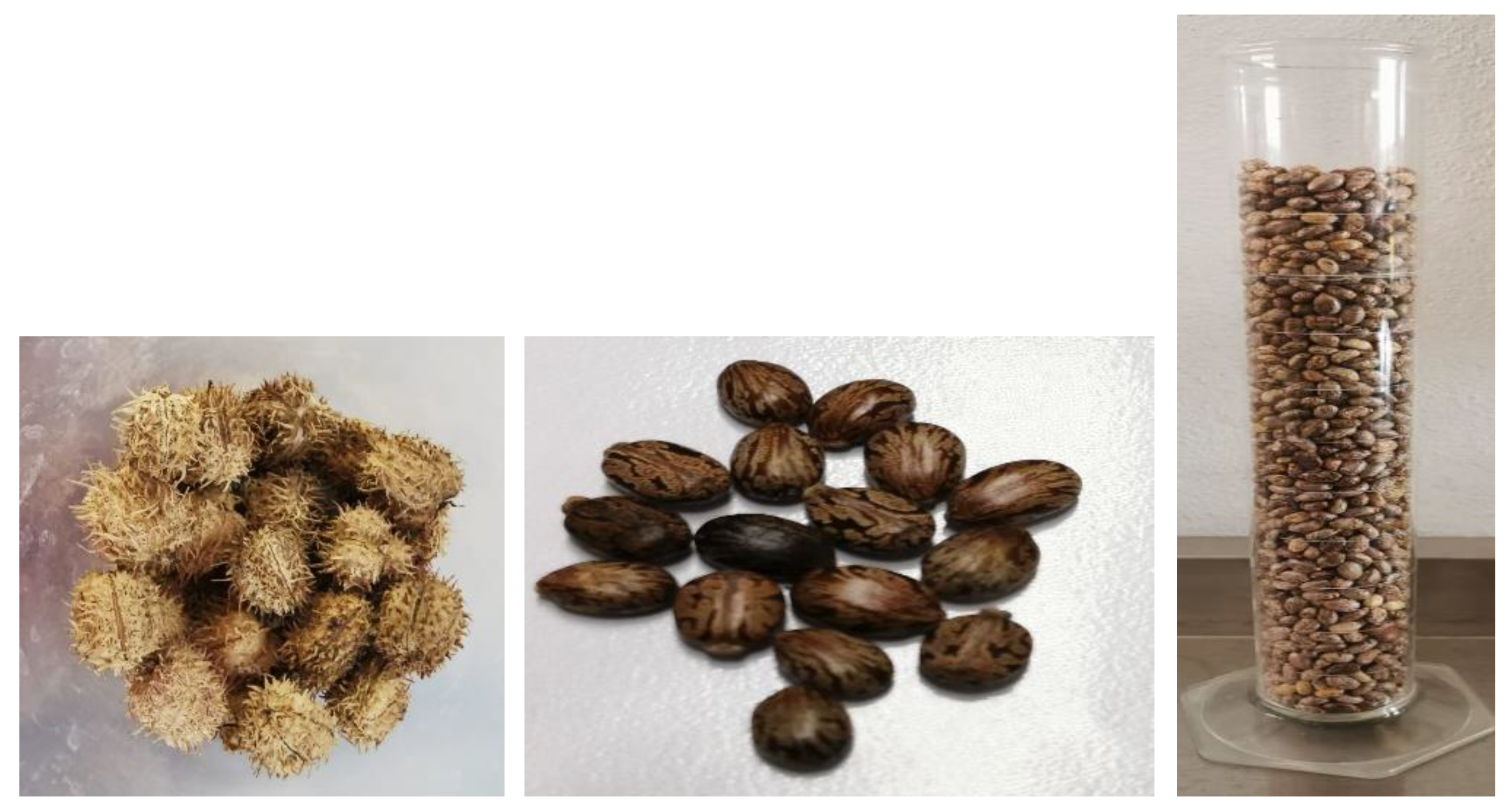
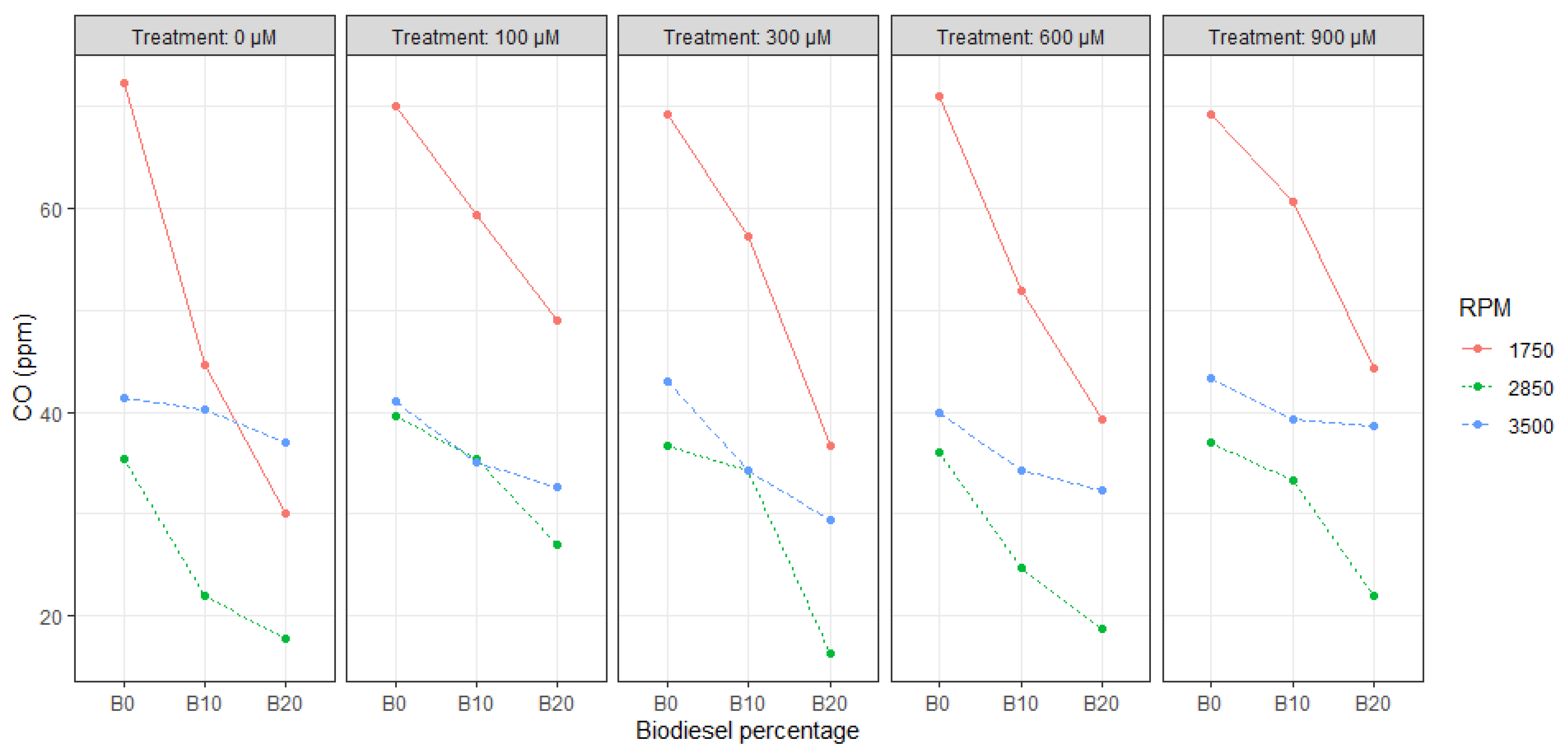
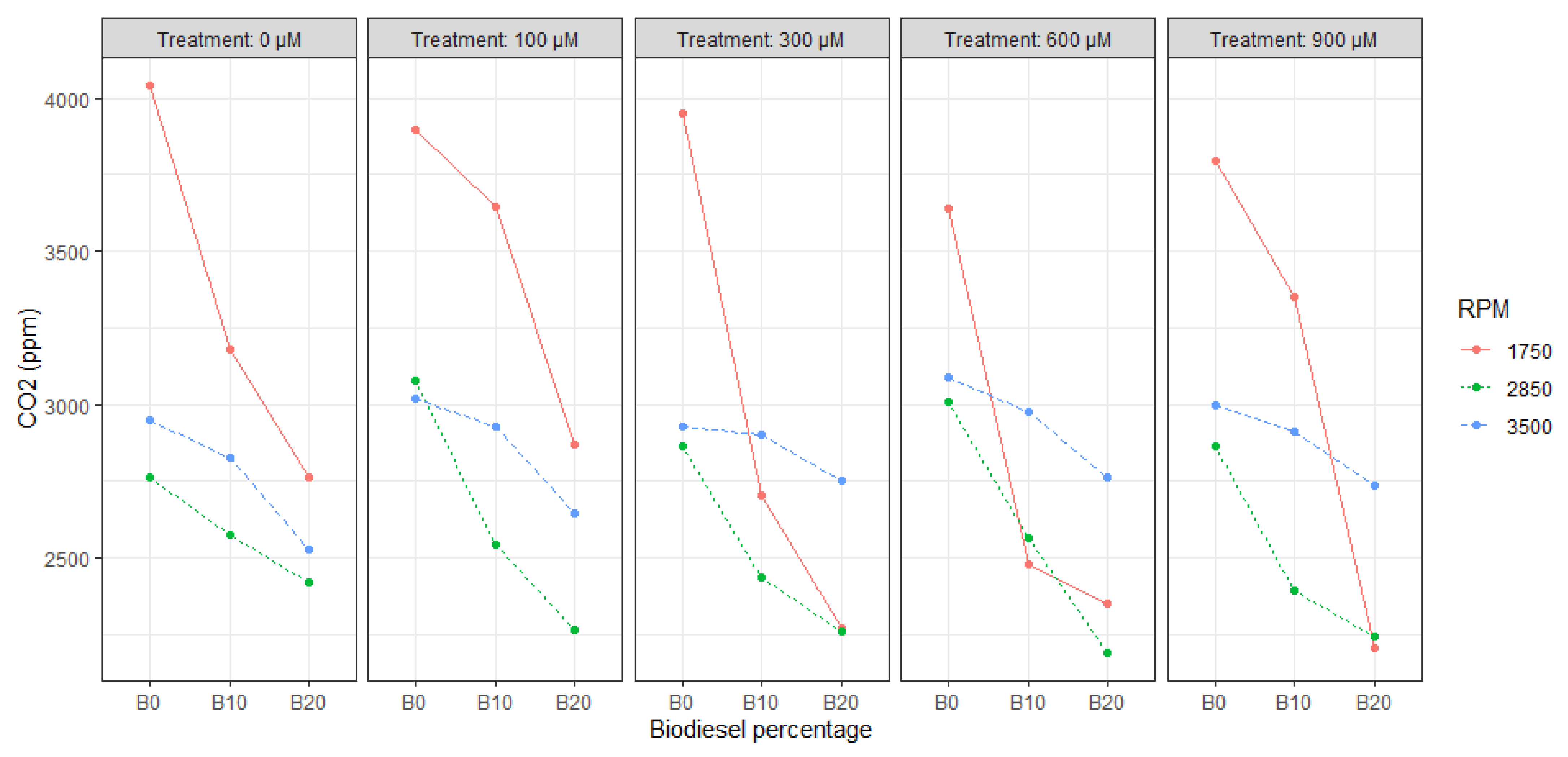
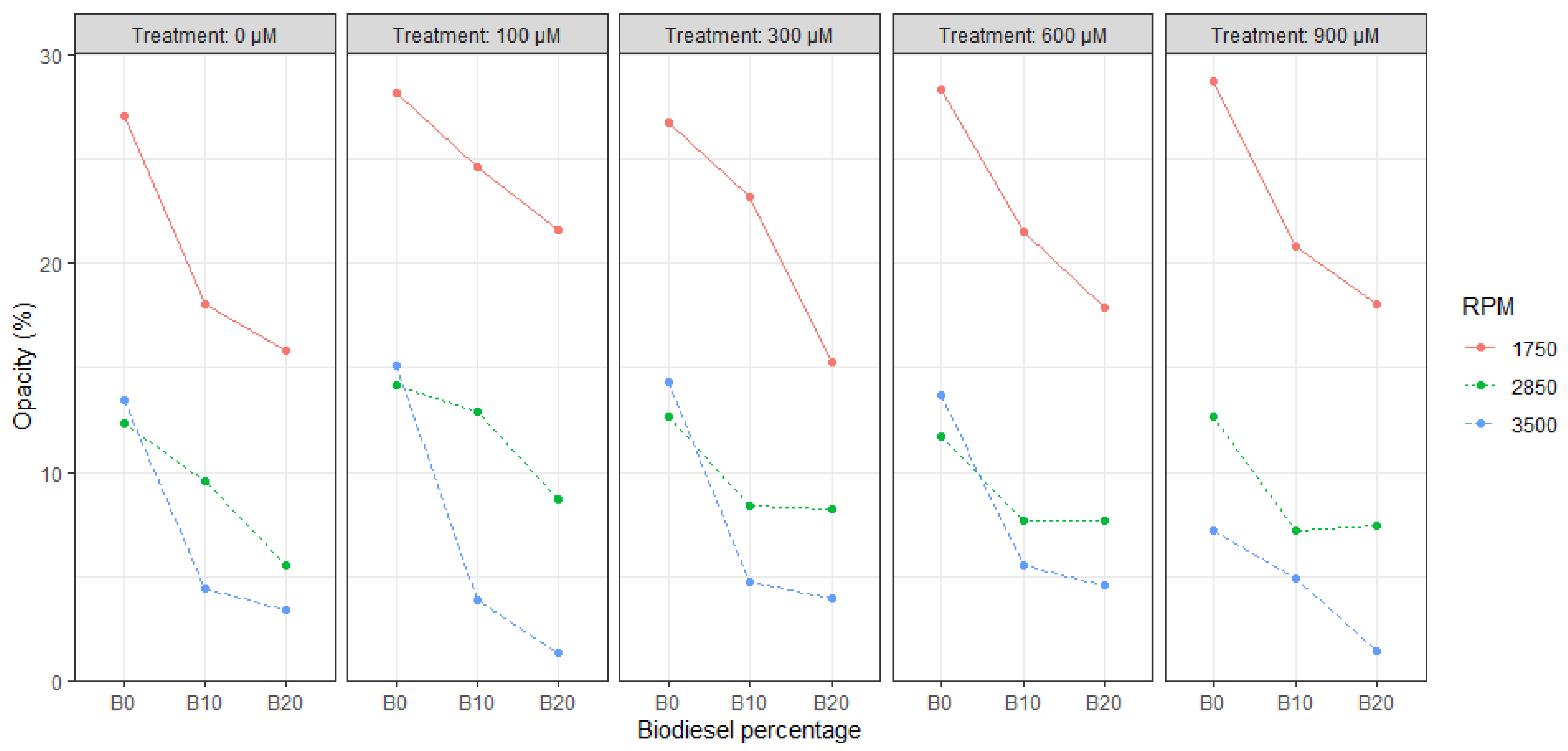
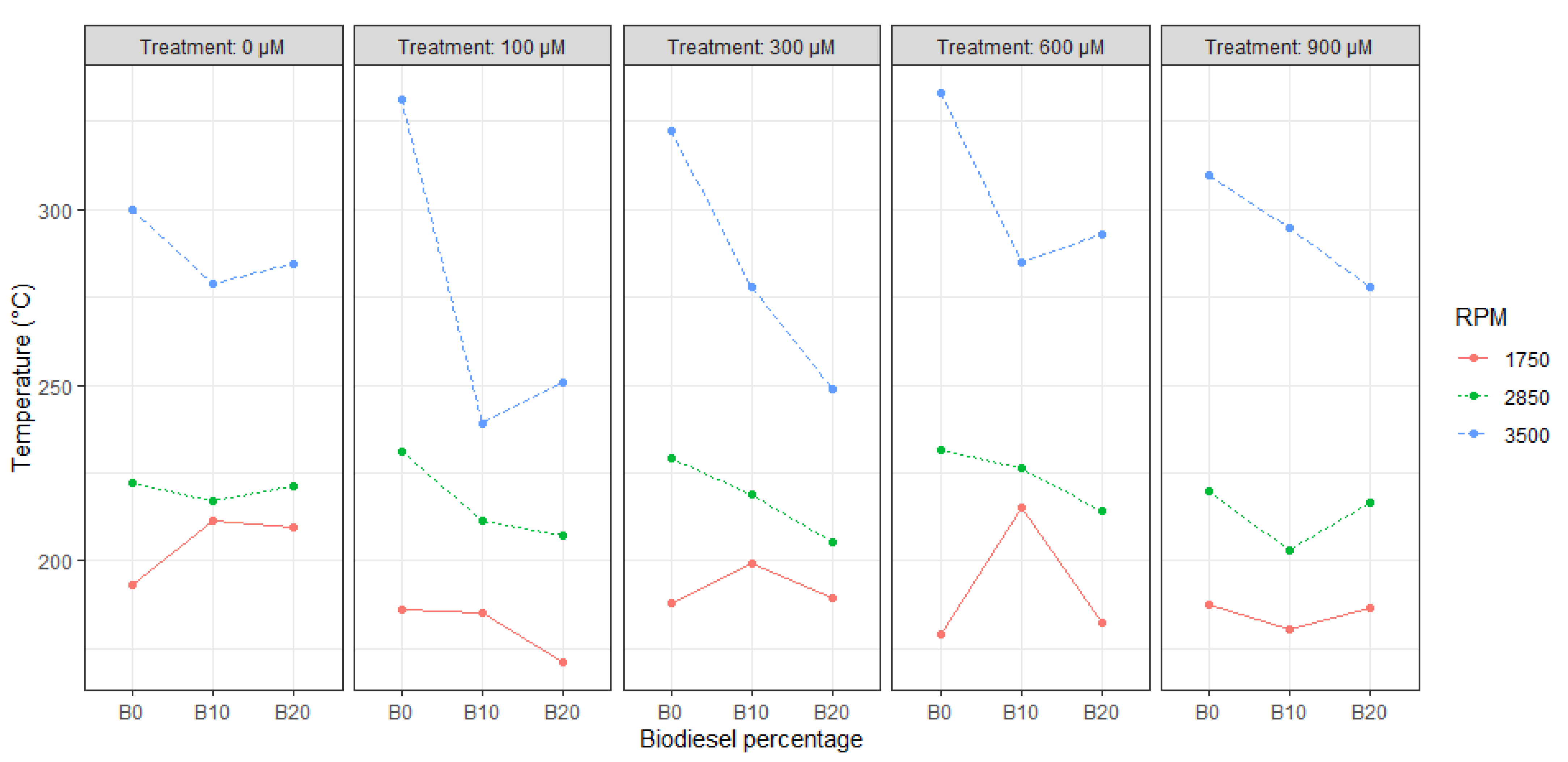
| Treatment | Total Weight of Bunches (Kg ha−1) | Weight of 1000 Seeds (g) |
|---|---|---|
| 900 µM | 5887 | 511.1 ± 1.6 A |
| 600 µM | 5322 | 446.7 ± 2.4 B |
| 300 µM | 5124 | 390.2 ± 0.8 C |
| 100 µM | 4283 | 357.4 ± 6.0 C |
| 0 µM | 4683 | 371.9 ± 4.2 C |
| Treatment | Oil Content (%) | Ricinoleic Acid (%) | Linolenic Acid (%) | Oleic Acid (%) | Linoleic Acid (%) | Stearic Acid (%) | Palmitic Acid (%) |
|---|---|---|---|---|---|---|---|
| 900 µM | 51.2± 1.6 A | 71.7 ± 2.6 A | 13.9 ± 2.3 A | 6.6 ± 0.8 A | 2.3 ± 0.4 A | 3.3 ± 0.5 A | 2.2 ± 0.7 A |
| 600 µM | 44.7± 2.4 B | 72.0 ± 2.6 A | 12.5 ± 0.7 A | 7.7 ± 3.1 A | 2.4 ± 0.7 A | 2.9 ± 0.4 A | 2.6 ± 1.3 A |
| 300 µM | 39.2± 0.8 C | 74.4 ± 1.3 A | 12.1 ± 0.6 A | 6.2 ± 0.7 A | 2.5 ± 0.4 A | 3.0 ± 0.2 A | 1.9 ± 0.2 A |
| 100 µM | 35.9± 6.0 C | 74.4 ± 1.2 A | 12.0 ± 0.5 A | 6.3 ± 0.5 A | 2.4 ± 0.6 A | 3.0 ± 0.5 A | 1.9 ± 0.2 A |
| 0 µM | 37.3± 4.2 C | 74.7 ± 4.3 A | 11.6 ± 2.1 A | 5.8 ± 2.4 A | 3.1 ± 0.3 A | 2.8 ± 1.3 A | 1.9 ± 0.9 A |
| SA Treatment | Density (g mL−1) | Kinematic Viscosity (mm2 s−1) | Ash Content (%) | Calorimetry (MJ Kg−1) | Inflammability Point (°C) | PH |
|---|---|---|---|---|---|---|
| 0 µM | 0.91 ± 0.00016 A | 15.46 ± 0.0072 A | 0.029 ± 0.00016 A | 40.49 ± 0.31 A | 175.33 ± 0.67 A | 7.6 ± 0.042 A |
| 100 µM | 0.911 ± 0.00028 A | 15.53 ± 0.0054 A | 0.029 ± 0.00018 A | 39.83 ± 0.27 A | 162.73 ± 0.38 A | 7.5 ± 0.039 A |
| 300 µM | 0.911 ± 0.00041 A | 15.67 ± 0.0136 A | 0.028 ± 0.00019 A | 39.18 ± 0.45 A | 150.14 ± 0.40 A | 7.6 ± 0.041 A |
| 600 µM | 0.911 ± 0.00032 A | 15.16 ± 0.0113 A | 0.028 ± 0.0002 A | 40.8 ± 0.54 A | 167.54 ± 0.43 A | 7.6 ± 0.047 A |
| 900 µM | 0.91 ± 0.00045 A | 15.85 ± 0.0103 A | 0.028 ± 0.00019 A | 40.12 ± 0.15 A | 183.88 ± 0.40 A | 7.5 ± 0.044 A |
| SA Treatment | Oil Weight (g) | Biodiesel Weight (g) | Biodiesel Conversion Yield (%) |
|---|---|---|---|
| 0 µM | 1950 | 1749 | 89.69 |
| 100 µM | 2387 | 2126 | 89.06 |
| 300 µM | 1692 | 1517 | 89.65 |
| 600 µM | 1858 | 1674 | 90.09 |
| 900 µM | 2406 | 2168 | 90.1 |
Publisher’s Note: MDPI stays neutral with regard to jurisdictional claims in published maps and institutional affiliations. |
© 2022 by the authors. Licensee MDPI, Basel, Switzerland. This article is an open access article distributed under the terms and conditions of the Creative Commons Attribution (CC BY) license (https://creativecommons.org/licenses/by/4.0/).
Share and Cite
Galván-Camacho, L.A.; Feregrino-Pérez, A.A.; De Moure-Flores, F.J.; Morales-Hernández, L.A.; Campos-Guillen, J.; Rodríguez-Morales, J.A.; Flores-Macias, A.; Quezada-Morales, D.L.; Zavala-Gómez, C.E.; Ramos-López, M.A. Assessment of Salicylic Acid in Castor Oil Content Increase in Emissions of Its Biodiesel Blends. Energies 2022, 15, 9463. https://doi.org/10.3390/en15249463
Galván-Camacho LA, Feregrino-Pérez AA, De Moure-Flores FJ, Morales-Hernández LA, Campos-Guillen J, Rodríguez-Morales JA, Flores-Macias A, Quezada-Morales DL, Zavala-Gómez CE, Ramos-López MA. Assessment of Salicylic Acid in Castor Oil Content Increase in Emissions of Its Biodiesel Blends. Energies. 2022; 15(24):9463. https://doi.org/10.3390/en15249463
Chicago/Turabian StyleGalván-Camacho, Luis Armando, Ana Angélica Feregrino-Pérez, Francisco Javier De Moure-Flores, Luis Alberto Morales-Hernández, Juan Campos-Guillen, José Alberto Rodríguez-Morales, Antonio Flores-Macias, Diana Laura Quezada-Morales, Carlos Eduardo Zavala-Gómez, and Miguel Angel Ramos-López. 2022. "Assessment of Salicylic Acid in Castor Oil Content Increase in Emissions of Its Biodiesel Blends" Energies 15, no. 24: 9463. https://doi.org/10.3390/en15249463
APA StyleGalván-Camacho, L. A., Feregrino-Pérez, A. A., De Moure-Flores, F. J., Morales-Hernández, L. A., Campos-Guillen, J., Rodríguez-Morales, J. A., Flores-Macias, A., Quezada-Morales, D. L., Zavala-Gómez, C. E., & Ramos-López, M. A. (2022). Assessment of Salicylic Acid in Castor Oil Content Increase in Emissions of Its Biodiesel Blends. Energies, 15(24), 9463. https://doi.org/10.3390/en15249463








